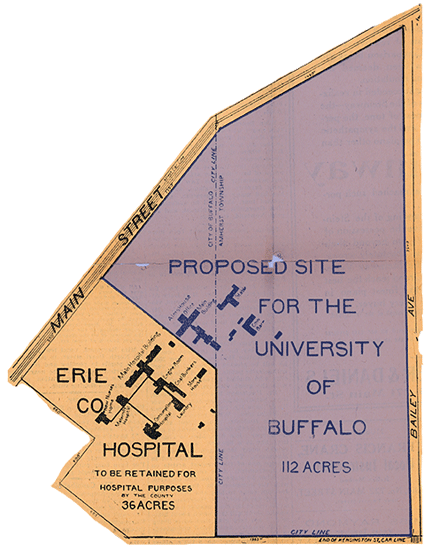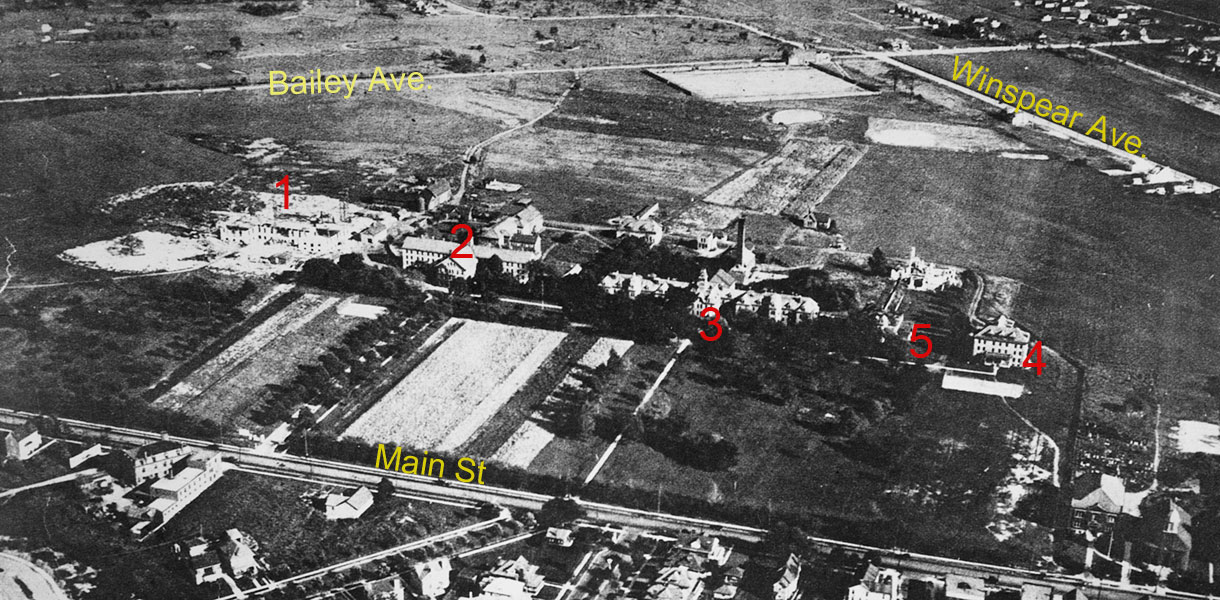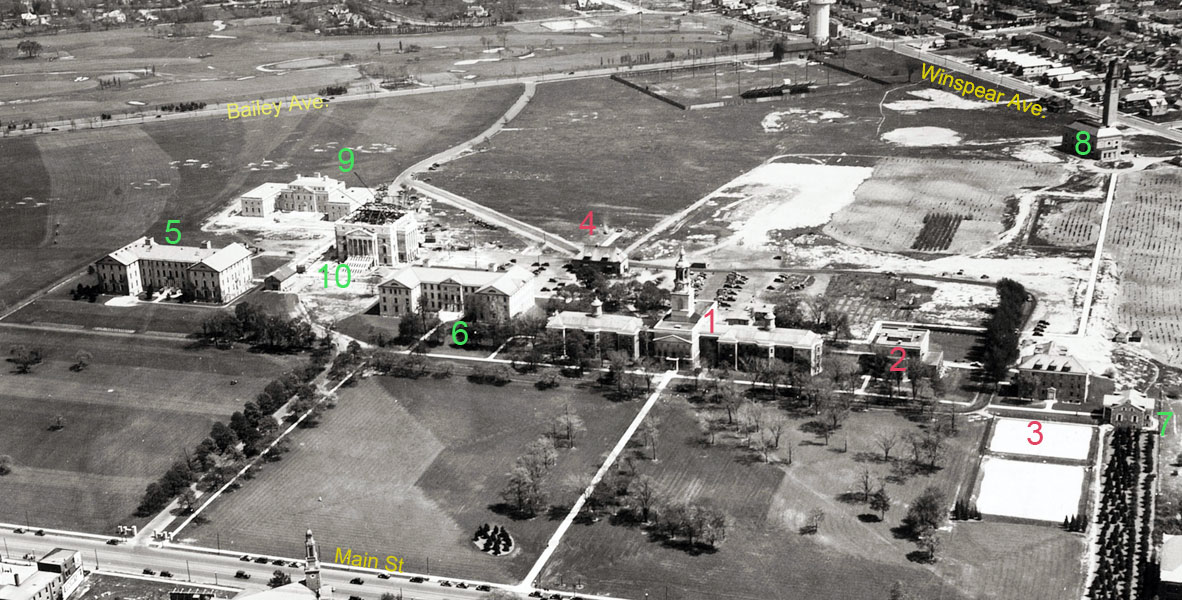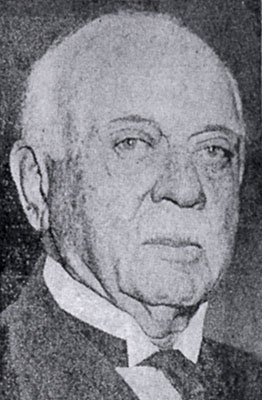 Orange outline in the map at left scribes the county's complete holding at Main and Bailey for the almshouse, hospital and farm. Purple shaded area represents the 106 acres the University offered to purchase. Image source: UB Archives
Orange outline in the map at left scribes the county's complete holding at Main and Bailey for the almshouse, hospital and farm. Purple shaded area represents the 106 acres the University offered to purchase. Image source: UB Archives
Edward Michael joined the Council of the University at Buffalo in 1906. The University, founded in 1846 as a medical school, had grown to included a school of pharmacy (1886), a law school (1887), and a school of dentisry (1892). In 1905, Vice-Chancellor Charles Norton proposed that the university engage in a $1 million dollar expansion and look into purchasing a 10-acre tract that stood adjacent to the Albright Art Gallery and the Buffalo History Museum on Elmwood Avenue. This was deemed "too ambitious" and so, by 1907, another piece of land on Elmwood near the Pierce Arrow plant was being considered; it was 40 acres. But Michael, a local real estate magnate, learned that Erie County was looking to move its almshouse out of the city. Michael walked the almshouse property at Main Street and Bailey Avenue several times, looking it over. He decided that the location was ideal for the university's future needs. He and John Lord O'Brian persuaded the University Council to forget about the Elmwood property. It was too small and too expensive. The university could purchase 106 acres of land for around $50,000. Michael handled the negotiations with the county. The selling price was a fraction of what the land was assessed. In 1909, the university took the deed to the land. The only catch was that the university had to take possession of the land within 10 years or it reverted to county ownership. Beyond a down payment, the university had no funds at all.
Michael began fundraising on his own. The purchase of this property would become important because, in 1913, the American Medical Association decreed that medical students must have at least one year of an Arts and Sciences curriculum. UB began offering coursework at the High Street Medical School. But in 1915, good fortune visited UB in the form of the Women's Union building on Niagara Square. The Union was closing and offered the building to the university for its Arts and Sciences classes with two conditions: the university must raise $100,000 and the building must be called Townsend Hall after the Union's longtime president, Harriet Townsend. Grace Millard Knox stepped forward to donate $250,000 in 1916 and the university took possession of Townsend Hall.
But World War I intervened and, in 1919, the university had built nothing at the new tract at Main and Bailey. After receiving a one-year extension, Chancellor Norton held a symbolic ground-breaking in 1920, thus satisfying the terms of the purchase. Fundraising now began in ernest, with UB Council member Walter Cooke replicating the type of fundraising strategies he successfully used to sell Liberty Bonds for the war. Edward Michael, who had begun his tenure as chair of the UB building and grounds committee in 1919, began work on the new campus. The Council hired McKim, Mead and White of New York City to design its first building, which would be known as Foster Hall. It opened in 1922, at which time the Arts and Sciences school was moved from Townsend Hall in Niagara Square to the new building.

1922 ariel view of the UB Campus. Image source: UB Archives
The county retained its hospital, a maternity building, and nurses' residence on land not sold to the university. UB Students and county residents were separated by wooden barricades. In the aerial photo above one can see the beginnings of the university's possession of the land. Note that the farmland between the buildings and Main Street is still under cultivation by the almshouse residents. Building (1) is Foster Hall under construction; (2) is former almhouse office building; (3) is the County Hospital which, by 1922, served elderly indigent residents; (4) the nurses' residence; (5) maternity hospital. Other buildings belonging to the county include storage, kitchens, heating plant, etc.
In 1926, Erie County opened its Home and Infirmary in Alden and vacated the remaining buildings which had been sold to UB. With the addition of these 44 acres and another 28 acres purchased from private owners, the university owned a total of 178 acres which define the South Campus in 2013. The challenge would then be to build and remodel.
Edward Michael and the Council decided to hire the Buffalo firm of E.B. Green and Son to "investigate the whole matter of reconstruction of buildings and location of buildings with a view of securing a harmonious treatment of all buildings and space involved."

1933 aerial view of the UB campus. Image source: UB Archives
 Edward Michael at age 100.
Edward Michael at age 100.
Image source: BECPL
Between 1930 and 1939, the following were built from E.B. Green designs: (6) Crosby Hall; (7) Beck Hall; (9) Norton Hall; (8) Mackay Heating Plant; (10) Lockwood Library. The architectural style of Crosby Hall was very similar to that of the earlier Foster Hall (5). The nurses's quarters (3), the maternity hospital (2), and the hospital building (1), were all substantially remodeled or rebuilt. (4) was a former county building used as a bookstore until Beck Hall was completed. All of this consruction was during the tenure of Edward Michael's chairmanship of the Building and Grounds committee, including Clark Gym not yet built in the photo above. The Courier-Express in 1950 credited Michael with developing the master plan for the arrangement of the buildings. It said that he ran a constant money-raising plan in those days and "was known to drive miles for a $5 or $10 donation." No construction detail was too minor for his examination. Geroge D. Crofts, UB Comptroller in 1950, recalled an example of this when he saw Michael prone on the ground in front of Norton Hall (now Harriman) to "get a good view and see that a row of eight elm trees was being planted properly."
The Buffalo Evening News said in 1950 that he "vigilantly watched every detail of the construction. Working closely with the architects and contractors, he spent hours, days and months keeping tabs on the progress of each building." When Michael died, the News said that the campus had been "his baby, and he carefully guided each step of its growth." It credited the design of the iconic Hayes Hall bell tower to Michael, saying that "the design of the Georgian tower for Edmund Hayes Hall came virtually from his own pencil."
In 1946, at age 96, Edward Michael stepped down from chairmanship of the Building and Grounds committee. He would have one last word about his "baby," this time during the construction of the engineering building that would one day be named after his close friend, Karr Parker. He insisted that it was unnecessary and a waste of money to install elevators in this new 3-story building. To prove his point, he climbed the stairs to the third floor without assistance at age 98 to attend the building's opening reception.
He persuaded his friend and fellow UB Council member Karr Parker to succeed him as chair of the Building and Grounds committee. The Courier-Express said: "...he asked the new chairman to come to his office. There he showed the astonished new chairman a great chest - a bride's chest that had originally come from Holland - in which reposed a mass of blueprints and documents relating to the buildings and plans for the university. It was necesary for the new chairman to send a truck to transport the chest and other documents accumulated over 28 years to his own office."

Michael Hall, UB South Campus. Currently, the Student Health Center
On his 100th birthday in 1950, a year before his death, the Courier-Express declared that, "it is perhaps more to him than to any other man the university was able to acquire and develop the present North Main St. campus, and rise to the point where today it has assets of more than $22,000,000 with 10,000 students."
Michael shrugged off such praise. "The University of Buffalo has come to its high point through the work of two men," he said. "Charlie Norton (vice chancellor from 1905 through 1909 and chancellor from 1905 to 1920) kept the spark alive and Chancellor (Samuel P.) Capen breathed on it and made it burn. The work that the rest of us have done has been small compared to what these two men have accomplished."
The University at Buffalo in 2013 recognizes Chancellors Norton and Capen above all others in the building of the university. But shortly after Edward Michael's death in 1951, the university began construction of three dormitories. One, built in 1954 for male students, was named Michael Hall in honor of Edward Michael. The man who was well-educated but never attended college, said, "I have always been interested in seeing that young men get an education. A college education gives a young man confidence in himself, self-assurance. In college, you make friends who stay with you for life. That's very important."
To learn more about Edward Michael's long and eventful life, see Part I of this story here.